Insert Online or Offline video in Word document – 3 useful ways
AuthorXiaoyang•Last modified
Adding videos to a Microsoft Word document can transform static text into an interactive and engaging multimedia experience. Microsoft Word lets you easily include videos from your computer or the internet right in the document itself. This means you can play videos directly within Word, making your document more dynamic and keeping your readers engaged without them needing to leave the document. Below is a detailed guide on how to embed both offline (local) and online videos into your Word document using different methods.

Insert Offline / Local video in Word document
This section will detail the process of inserting offline or local videos into a Word document, offering step-by-step instructions along with tips to optimize the viewing experience.
Insert Offline / Local video in Word with Object feature
Embedding an offline or local video in a Microsoft Word document using the Object feature is a powerful way to enhance your document’s interactivity and provide rich content directly within your text.
- Open the Word file and place the cursor where you want to insert the video.
- Click "Insert" > "Object" > "Object".

- In the "Object" dialog box, do the following:
- Click the "Create from File" tab.
- Click the "Browse" button to navigate to the video file on your computer, select it, and click "Insert".
- Click "OK" to insert the video.
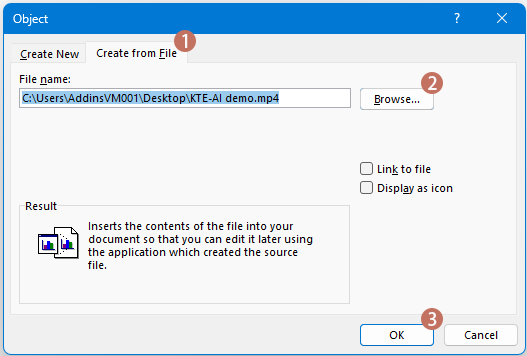 Tips: In the Object dialog box, there are two additional options:
Tips: In the Object dialog box, there are two additional options:- Link to file:
- Check this option to create a link to the video file’s location on your computer. This keeps the file size small, but the video won’t play if the document is moved to another device without the video file.
- If unchecked, the video is embedded into the Word document, increasing its size but making it self-contained and portable.
- Display as icon:
- If checked, the video will appear as an icon in the document instead of a thumbnail.
- Link to file:
- After the video is inserted, it will appear as a video icon in your document.
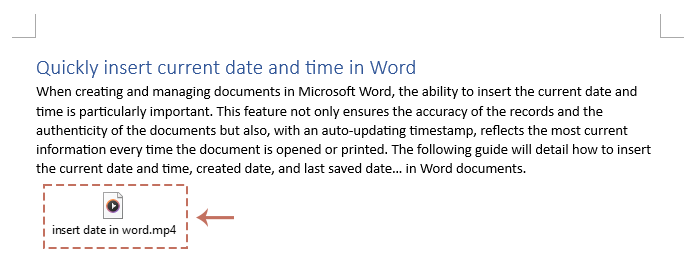
- Double-click the video icon to play the video. When the "Open Package Contents" dialog appears, click "Open" to launch the video in your default media player.
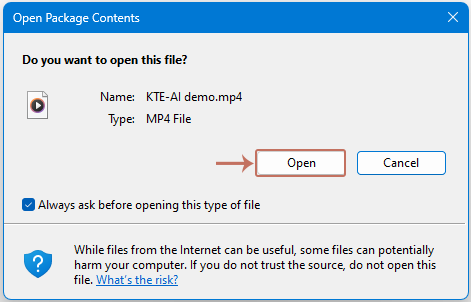
- Advantages:
- The video is stored directly within the Word document, so users don’t need to download separate files or follow external links.
- Considerations:
- Embedding videos can significantly increase the file size, which may cause issues when sharing via email or other size-restricted platforms.
- Some video formats might not be compatible across different systems or versions of Word.
Insert Offline / Local video in Word with Windows Media Player
Incorporating offline or local videos into a Microsoft Word document using Windows Media Player can greatly enhance your document's interactivity and appeal. This method allows you to embed a video with familiar playback controls directly within your document, making it an excellent choice for dynamic presentations or instructional materials. Here’s a detailed guide on how to insert an offline or local video in Word using Windows Media Player.
- Open the Word file and place the cursor where you want to insert the video.
- Click "Developer" > "Legacy Tools" > "More Controls".

- In the "More Controls" dialog box, scroll through the list and select "Windows Media Player", then click "OK".
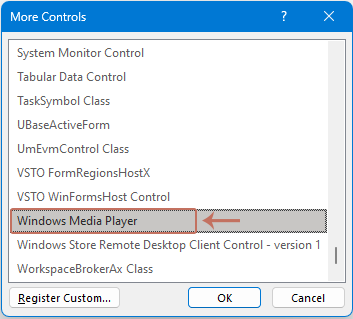
- A media player will be inserted into the document. Resize the player as needed.
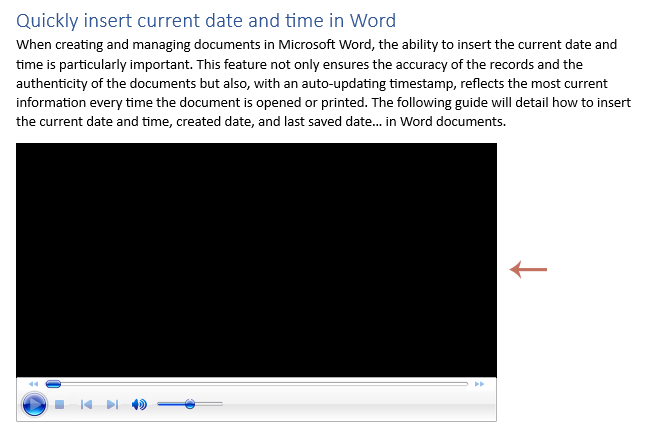
- Right-click the embedded Windows Media Player control and select "Properties" from the context menu.

- In the "Properties" pane, click "Custom" to reveal the
 button. Then, click the button.
button. Then, click the button.

- In the "Windows Media Player Legacy Properties" dialog box, click the "Browse" button to locate and select your video file. Then click "OK".
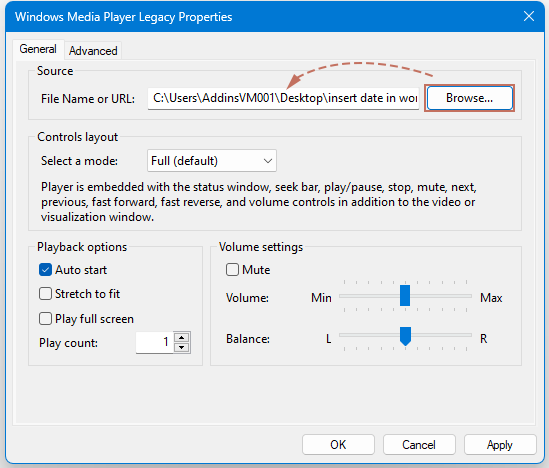
- Close the "Properties" pane. To play the inserted video, click "Design Mode" under the "Developer" tab to exit design mode.
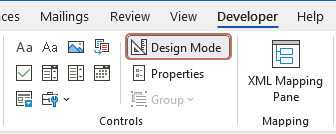 Tips: While Design Mode is enabled, you can freely adjust the size and position of the video player to fit your document’s layout.
Tips: While Design Mode is enabled, you can freely adjust the size and position of the video player to fit your document’s layout. - Now the video starts playing. You can pause or resume playback as needed.

- Advantages:
- Directly embedding the Windows Media Player allows for easy use of video controls like play, pause, and stop, without the need to open a separate player.
- Considerations:
- This method is only compatible with Windows systems that have Windows Media Player installed, which can be limiting if the document needs to be viewed on non-Windows devices.
- Since this approach uses a linked path, the video will not be viewable if the file path changes or if the document is used on another computer that does not have access to the same file path.
Insert Online video in Word document
This section will walk you through the process of embedding online videos into your Word documents, offering a step-by-step tutorial to enrich your text with media content seamlessly.
- Open the Word file and place the cursor where you want to insert the video.
- Click "Insert" > "Online Videos".

- In the dialog box that appears, paste the URL of the video from a supported platform such as YouTube or Vimeo. Then, click the "Insert" button.
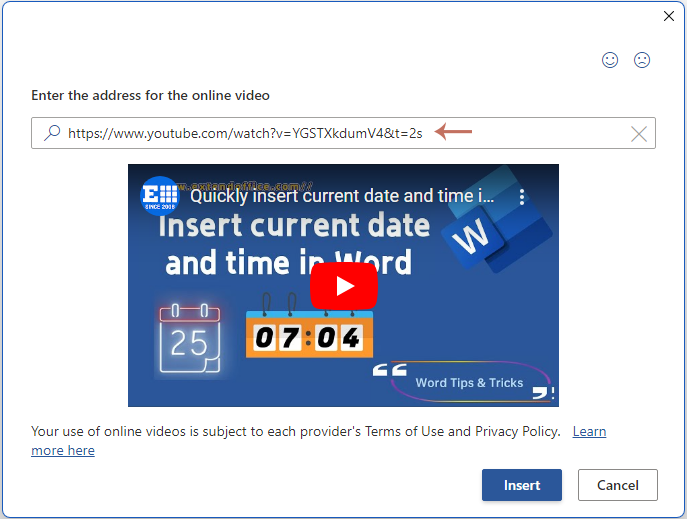
- Now the video will be embedded into your document.
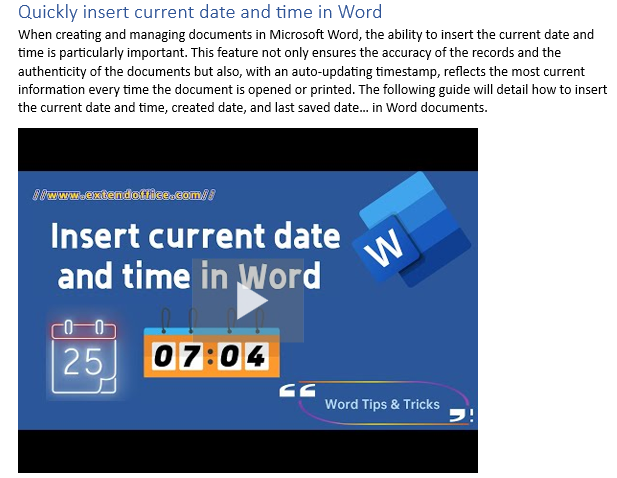
- Supported sources:
- ◆ YouTube ◆ SlideShare ◆ Vimeo ◆ Stream ◆ Flip ◆ TED
- Advantages:
- ◆ Since the video is streamed online, this method does not increase the size of the Word document.
- ◆ Videos can be inserted easily by URL or search, especially from supported sites like YouTube.
- Considerations:
- ◆ An internet connection is required to view the video.
- ◆ The video may become inaccessible if removed or if the link changes on the source platform.
In summary, embedding videos into a Microsoft Word document can significantly enhance its interactivity and appeal by integrating dynamic multimedia content. Whether you are incorporating offline videos through the Object feature or Windows Media Player, or embedding online videos via links to platforms like YouTube or Vimeo, each method offers unique advantages and considerations. By understanding these options, you can choose the most appropriate method to enrich your Word documents with video content tailored to your specific needs and circumstances. To explore more tips and tricks for Microsoft Word, please click here to view additional options.
Generate tailored content with Kutools for Word's AI feature
Transform your document creation process with Kutools AI Assistant's tailored content generation feature. Whether crafting a detailed report, composing compelling emails, or developing engaging presentations, Kutools AI Assistant molds your ideas into polished, ready-to-use text. Let Kutools AI Assistant be your partner in writing success, tailoring content that resonates and impresses. To use this Kutools AI Assistant of Kutools for Word, please download and install Kutools for Word first.
Related Articles:
- Insert Emoji in Microsoft Word
- Emojis have become an integral part of digital communication, adding emotional nuance and clarity to text in a fun and visually appealing way. In Microsoft Word, integrating emojis can enhance your documents, whether you’re adding flair to your content or conveying emotions more effectively. This comprehensive guide will walk you through various methods to insert emojis into your Word documents across different platforms and versions.
- Insert table of contents in Word
- Creating a table of contents in a long word document may help you to quickly navigate to the part of the content as you need. This article, I will talk about how to insert table of contents quickly and easily in a Word file.
- Insert header or footer with page number in Word
- Normally, when you insert page number for a Word document, the existing header or footer will be removed automatically. How could you insert both the header or footer and page numbers into a Word file?
- Insert multiple pictures with same size in Word
- Normally, you can insert multiple images at once in a Word document with their original size. Sometimes, you need to arrange these images to the same size when inserting. This article, I will talk about how to insert multiple pictures with the same size in a Word document.
Best Office Productivity Tools
Kutools for Word - Elevate Your Word Experience
🤖 Kutools AI Features: AI Assistant / Real-Time Assistant / Super Polish (Preserve Format) / Super Translate (Preserve Format) / AI Redaction / AI Proofread...
📘 Document Mastery: Split Pages / Merge Documents / Export Selection in Various Formats (PDF/TXT/DOC/HTML...) / Batch Convert to PDF...
✏ Contents Editing: Batch Find and Replace across Multiple Files / Resize All Pictures / Transpose Table Rows and Columns / Convert Table to Text...
🧹 Effortless Clean: Sweap away Extra Spaces / Section Breaks / Text Boxes / Hyperlinks / For more removing tools, head to the Remove group...
➕ Creative Inserts: Insert Thousand Separators / Check Boxes / Radio Buttons / QR Code / Barcode / Multiple Pictures / Discover more in the Insert group...
🔍 Precision Selections: Pinpoint Specific Pages / Tables / Shapes / Heading Paragraphs / Enhance navigation with more Select features...
⭐ Star Enhancements: Navigate to Any Location / Auto-Insert Repetitive Text / Toggle Between Document Windows / 11 Conversion Tools...
🌍 Supports 40+ Languages: Use Kutools in your preferred language – supports English, Spanish, German, French, Chinese, and 40+ others!

Office Tab - Tabs for Office, Power for You
- Enable tabbed editing and reading in Word, Excel, PowerPoint, Publisher, Access, Visio and Project.
- Open and create multiple documents in new tabs of the same window, rather than in new windows.
- Increases your productivity by 50%, and reduces hundreds of mouse clicks for you every day!

✨ Kutools for Office – One Installation, Five Powerful Tools!
Includes Office Tab Pro · Kutools for Excel · Kutools for Outlook · Kutools for Word · Kutools for PowerPoint
📦 Get all 5 tools in one suite | 🔗 Seamless integration with Microsoft Office | ⚡ Save time and boost productivity instantly
Best Office Productivity Tools
Kutools for Word - 100+ Tools for Word
- 🤖 Kutools AI Features: AI Assistant / Real-Time Assistant / Super Polish / Super Translate / AI Redaction / AI Proofread
- 📘 Document Mastery: Split Pages / Merge Documents / Batch Convert to PDF
- ✏ Contents Editing: Batch Find and Replace / Resize All Pictures
- 🧹 Effortless Clean: Remove Extra Spaces / Remove Section Breaks
- ➕ Creative Inserts: Insert Thousand Separators / Insert Check Boxes / Create QR Codes
- 🌍 Supports 40+ Languages: Kutools speaks your language – 40+ languages supported!








 button. Then, click the button.
button. Then, click the button.






